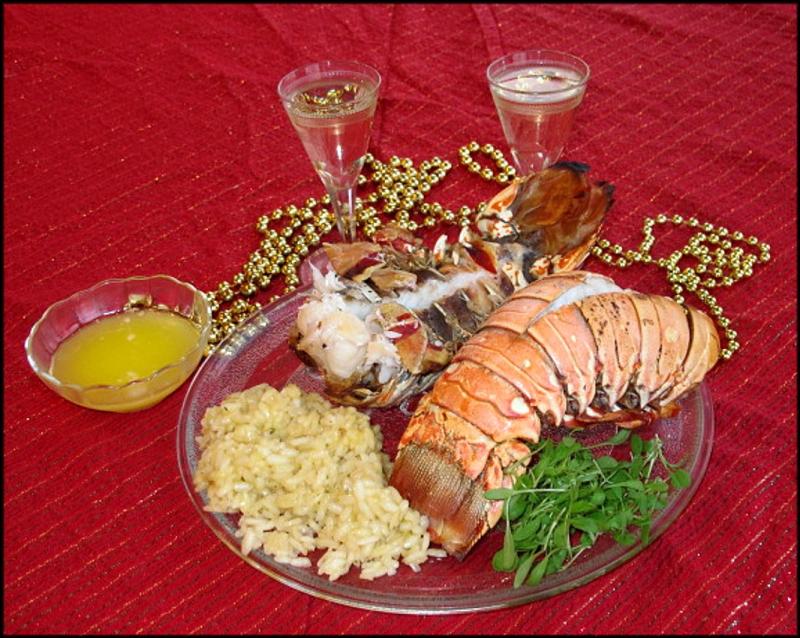Sumptuous New Year’s Day dinner greets 2022 on a high note
Today is the last day of 2021, which for so many of us has been a challenging 12 months. Despite vaccines and boosters, some of our friends and family members have contracted the miserable virus, and we can’t be with them to ring in the new year. To make up for the quiet evening, we’re planning an elegant dinner of broiled lobster tails for our New Year’s Day celebration.
Many local grocery chains and specialty markets have lobsters available, both live specimens and frozen tails, the latter in a wide range of sizes and prices, ranging from $10 to $50 for each tail. Of course, the size and price point scale up proportionally, so you can balance the decadent lobster with other items on the menu to make your meal more affordable.
I could never bring myself to purchase a live lobster, so we’ve always turned to the frozen tails, which need to be gently defrosted before cooking. The best way is to place them in a rimmed baking pan lined with paper towels (to absorb the ice melt). They should go into the fridge the day before you plan to make them so they can thaw naturally. Another option is to submerge frozen lobster tails in cold water for about 90 minutes to thaw more rapidly.
You’ll want them to thaw completely so the meat can cook evenly. Don't even think about using the microwave to defrost them, as this will make the meat tough and chewy instead of tender and juicy. There are two ways to cook your lobster tails in water: boiling can dilute the flavor, while steaming is a better option. The two oven options are baking and broiling, while grilling will give the flavor some smoky notes.
When the lobster tails are raw, the shells will contain a range of color shades, from deep black to oranges and tans. Once cooked, the underlying pink and red colors become visible due to the pigment called astaxanthin. This process is not unlike the way tree leaves become orange and gold in the fall as the chlorophyll breaks down and green no longer masks the other colors. As you can see in the photo, not all shells will become bright red, even though the meat is properly cooked.
Another thing you can see in the photo is my not-quite-perfect preparation techniques. To keep the shell from curling, you need to cut lengthwise through it on top of the meat to separate the meat from the shell, giving it the opportunity to cook quickly. Although I thought I had cut through it sufficiently, the results are evidence I must have missed a spot.
You can also remove the meat from its shell, place a lemon wedge in the shell and arrange the meat on top. You’ll want to drizzle a generous amount of melted butter over the lobster meat and sprinkle on your favorite seasonings – paprika and Old Bay are always good choices; salt is a must. If baking or broiling the tails, a little bit of wine in the bottom of the pan helps keep the meat moist.
Cooking times will vary based on the size of the tails; plan on about 2 minutes per ounce. The lobster meat will become bright white as it cooks and the shell will redden. To make sure it’s fully cooked, insert a digital meat thermometer into the fattest part of the lobster tail (avoid touching the shell). Fully cooked lobster will have 140-145 F degrees as an internal temperature.
Now that you’re ready to make the main course, you can pay some attention to the side dishes. We started with a caesar salad and served the lobster tails with drawn butter and tarragon-laced risotto, which cooked on the stovetop while the oven heated and the lobster broiled. Champagne or Prosecco are the perfect companions to these lush flavors, with just the right balance of bubbles. Happy New Year!
Broiled Lobster Tails
2 6-oz lobster tails, thawed
1 lemon
1 T melted butter
1/4 t paprika
1/4 t Old Bay
salt, to taste
2 T white wine
warm drawn butter
Preheat broiler to high. Place lobster tails in a rimmed baking pan. Using sharp kitchen shears, carefully cut the top of the lobster tail shell down to the tip of the tail, avoiding the meat. Carefully pull the shell down and lift the meat so it’s sitting on top of the shell. Cut the lemon in half; quarter one half, zest and juice the other half. Nestle a lemon quarter beneath each lobster tail. In a small bowl, combine lemon juice and zest, melted butter, paprika and Old Bay. Sprinkle each tail with salt and brush with butter mixture. Pour wine into the pan and place under the broiler, at least 10 inches from heat source. Cook until the meat is white and opaque, and a meat thermometer registers 140 F, about 10 minutes. Serve with drawn butter for dipping.
Risotto
1 T butter
1 T olive oil
1 minced shallot
1/2 t salt
1 C arborio rice
1/2 t dried tarragon
1/4 C white wine
1 1/2 C vegetable broth
1/4 C grated Parmesan
Set the timer for 18 minutes. Combine butter and olive oil in a saucepan over medium heat. Add the shallot; cook until translucent, about 2 minutes, stirring often. Sprinkle with salt; stir in rice and tarragon. Cook until rice becomes translucent, about 2 minutes. Add wine and cook until liquid evaporates, about 2 minutes. Add the broth 1/2 C at a time and cook, stirring constantly. Once liquid is absorbed, continue adding more broth; make sure to prevent rice from sticking to the bottom of the pan. When timer sounds, stir in cheese, remove pan from heat and cover tightly until ready to serve.






















































